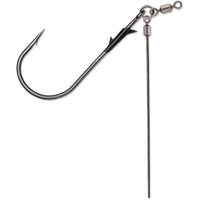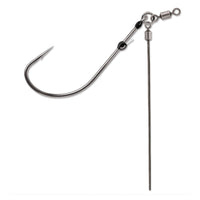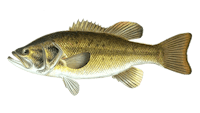Tokyo Rigging for Bass: Mastering the Art of Summer Fishing
Published: Updated:
Tokyo Rigging Today
All Featured Products

VMC Tokyo Rig With HD Flippin Hook - EOL
$4.69
Jump to 1:48

VMC Tokyo Rig Finesse Neko
$4.49
Jump to 2:15

VMC Tokyo Rig With HD Worm Hook - EOL
$3.79
Jump to 2:18

VMC Tokyo Rig Heavy Duty Wide Gap XLS
$3.99 – $4.99
$4.99Jump to 2:22

VMC Tokyo Rig Heavy Duty Wide Gap XLS
$3.99 – $4.99
$4.99Jump to 17:39
Discover the secrets of summer bass fishing with an in-depth exploration of Tokyo rigging techniques. This comprehensive guide delves into the tactics used by seasoned tournament anglers, offering insights into locating and catching bass in dense weed beds and heavy cover during the summer months.
Uncovering Bass Hotspots: GPS and Side Imagery Techniques
Learn how professional anglers use side imagery and GPS to identify key fishing spots in weed beds. This segment reveals the importance of finding hard bottoms or rocks within these areas, which become prime locations for bass in the summer.
Summer Patterns: Shallow and Deep Water Bass Fishing
Explore the various summer patterns of bass in both shallow and deep waters. Understand the behavior of bass around docks, lily pads, bull rushes, and in deep weed beds, and how to adapt your fishing strategy accordingly.
The Power of Tokyo Rigging in Dense Cover
Discover why the Tokyo rig is hailed as the ultimate presentation method for catching big bass in thick, dense, deep water cover. Learn about the rig's versatility and effectiveness in different conditions.
Deep Weed Bed Fishing Techniques
Gain insights into fishing in deep weed beds, including tactics for punching baits through dense weed canopies. This segment emphasizes the importance of making short casts and using heavy weights for effective fishing.
Adapting to Environmental Changes: Zebra Mussels and Weed Growth
Understand how environmental changes, like the introduction of zebra mussels, have altered the fishing landscape. This section discusses how these changes have led to deeper weed growth, impacting fishing strategies.
Historical Perspectives and Environmental Impact
Reflect on the historical changes in the fishing landscape over the years, with a focus on how zebra mussels have transformed water clarity and weed growth.
Choosing the Right Gear: Rods, Reels, and Lines for Heavy Cover
Learn about the essential gear needed for successful Tokyo rigging, including the importance of choosing the right rod, reel, and line to handle dense weed beds and heavy cover.
Maximizing Your Catch: Map Setup and Sonar Use
Discover how to use maps and forward-facing sonar effectively to locate the densest weed areas and identify key fishing spots within weed beds.
Conclusion: Tokyo Rigging for Big Bass
Conclude with an affirmation of the Tokyo rig's unmatched efficiency in heavy cover fishing. Highlight how this method is a favorite among professional anglers for targeting larger bass in challenging environments.
You know, I fish bass tournaments, regional bass tournaments around here. And the interesting thing is how these guys find spots in the summer going out in the spring. What they do is take side imagery and they'll go and drop GPS coordinates on any hard bottom or rocks in these weed beds. And that's where the fish go to during the summer. Got them. Got them. Yeah. Got them. Feels like a better one. Come on out of there, baby. Come on out of there. No. Little bit better. She grew up some.
You know, it's the middle of summer. And the bass are set up on all of their usual summer patterns. You know, in the lake that we're on, there's shallow water fish. They're on both docks. There's frog and lily pads, bull rushes. And then there's the deep water bass, the fish on the deep weeds. And heavy cover. And that's what we're fishing right now. And in many cases, when you get it right, they're the biggest bass in the system. Got them. Little better, Jim. Yep. That's a good one. A lot better. Yeah. It's a lot better. There's some big ones in here. A lot better.
This is so much fun. It's combat fishing. When you got a fish for big bass like this, in the thick, dense, deep water cover, nothing, there's not a better presentation method, period, than a Tokyo rig. I mean, this Tokyo rig came on the scene some years ago. And it is one deadly way. The fish, it goes through everything. It fishes in anything. It makes no difference. It's like when I first looked at this Tokyo rig when it came on the scene, I could pull a bass, really bite on that thing. Boy, do they bite on it. Big time.
And they put together Tokyo rigs now. We have them available in all different sizes, hook designs, and everything to cover every aspect of soft plastic concoctions that you could put on the back of them. Jimmy's fishing a craw tool right now. I'm fishing a big bite bait, best flipping bait ever, which I really like. But there's a variety of different kind of soft baits that fit into different size hooks and everything. It just gives you a basic idea of some of the bait you could use and this delivery system.
You know, a lot of people think weed fishing, and they think Florida, you see all the big lily pad beds, but realistically, we live up in the north country in our northern natural lakes. And we actually have some of the probably the best weed fishermen. And the reason being, we actually have a lot of really deep weeds. Right now, we're fishing in a weed bed that's 17-foot deep. And it's solid coontail, and I can actually see it. It's like three feet underneath the surface. And what we're attempting to do is to actually drive our baits directly down.
You'll notice that Alan and I are making very, very short casts. And that's for a couple of different reasons. Number one is your biggest goal is to take this Tokyo rig and actually just get it to penetrate to the bottom. The fish are on the bottom, and there's like a canopy of these weeds and then there's room underneath where the fish can swim. And what we're trying to do is to actually punch this thing right through this dense weed canopy. In this particular lake, we have actually a weeds grow down into 26-foot of water. It's actually changed a lot. This is actually my home lake in central Minnesota. It's a gull lake. And the intriguing thing was these weeds didn't used to be in this lake like this at all. The weeds were, the old weed lines in this lake used to be like 12-14 foot of water. Today with zebra mussels has changed a complexion of a lot of our lakes in the north country. We have weeds growing deeper than they've ever been before.
You got them. No. Not bad, Jim. There's one. Not bad, you too. I got a pretty decent one too. You got a big, now you're talking. Night, that's a nicer one. Huh? Pretty decent one. Take these all day long. You know, I look back at the history of the lake we're on. When I first got into business, I came back from Vietnam and I looked for a place to live with my brother, Ron. And we picked the Brainer Nisla area because of all the lakes. And I started guiding the Nisla gull lake. It was winter the lakes that I guided on for so many years. And Jimmy growing up as a kid when he started guiding, he fished your life. And let me clue you. What this lake looked like 50 years ago and what it is today? Oh man. The fishing is still, it's still one of the premier walleye lakes in the state. There's tons of bass tournaments on it every year because it's so good. Yeah, you know, zebra mussels got in there. And it changed the environment, the water got clear, we got weeds like we never had before. Changed a lot over the years, but it's still fun Jim.
Oh, there's one. Oh, oh, oh. Come on. Come here buddy. There's a good one there. Come on, there you go. You can see how healthy these fish are. The cool thing is about this Tokyo rig. You can see how dense this weed cover is. They actually make a couple of different versions of this rig. This actually is a five inch arm. They actually make a two and a half inch arm. And you'll notice that it'll get bent up. And that's really common when bass are biting on it, but you just take the pliers and just do a little tweaking on it to straighten it back out. But the biggest thing is what this does is bounce on the bottom and it keeps that bait suspended up off the bottom so they can find it. And the other thing is big weight. And with this I actually have almost like three quarters of an ounce on here. And that weight is really critical. Number one to get it down through the weeds, but the other thing is what it does is enable you when you hit the bottom. You're pounding the bottom. You actually have two different punks than VMC punks than weights. What these are doing is making a little bit of rattling sound. So what you're doing is attracting the fish to the bait.
Got him. Yeah. You got a real, real one there. Yeah. It feels good, Jim. You're still there, baby. I think you are. Yeah, she's in there. Look at this. Nice one too. Is that right? Yeah. She's... [laughs] Come on, come on, come on now. They have you up. Oh, that's a better one. That's a better one, all right. Man, it is like combat fishing. You know, to get these babies out of this stuff. You know, we got nice weather now. It's not been fast. We're punking here. One here, we're punching these weeks with one here. We know there's a lot of fish out here. But we're scrounging enough out. We got fish like that doing this. It's a lot of fun. A lot of fun. Let's get her back. All right, baby. There's one. Oh, there's one. Oh, that's what I mean. You got a lean on them, Bobs. Oh, it wasn't even a biggie. That's one thing, boy, you need the right equipment. The land these guys out of this stuff here. It's so dense, you've got to play with them in the boat. Boy, but they're just beautiful. Fish have really been fattening up. Living these deep. I mean, this is just a monstrous weed bed. It's like amazing on how big this area is. This is like literally, there's hundreds of acres of weeds that grow to 14 to 16 foot of water and they grow right to the surface.
One of the real keys to finding fish in weed beds is setting up your map correctly. Right now you'll notice that actually I went to my chart and I actually set my depth highlight to 16 foot of water. 16 foot of water in this lake is the edge of the deepest weeds. In this particular case, you can see what we're fishing here. This is actually a great big weed saddle. So you have deeper water out here, deep water hole in here, and then you actually have some of these coordinates. These coordinates are where we've caught fish already, but when I zoom in, you'll notice a couple of different things. You'll notice that there's some like high spots. There's a 14 foot hump right there. There's an 11 foot high spot there. Then there's a big point here that's a high spot. What that forms is the edges in the weed flat itself and that's what's really critical. A lot of times these fish are on specific spots within these weed beds. Like this 11 foot hump, actually if you took all the weeds off, there's actually rocks down in the intermittent spots on these weed plants. There can be really key spots to catch bass out of these weed beds like this.
Get rid of this. No, come here, come here, boy. Oh, there we go. Come on. There we go. It's sort of a no full and type system here. You hit them, you can see what that's the weeds right there. On the surface and we're in 14 foot of water. So you got to lean on them to get them out of there, especially when you get on the big ones. You get on the four and five pounders up in this lake here. It's really sort of interesting. You got to use really heavy duty line. Line is really, really critical for this type of fishing. Right now I'm using 131. This is 30 or 40 pound 131 braid. It's good really thin. And what that enables you to do when you set the hook on the fishes, that literally shears the weeds off. You know what I mean? That really thin braid is pretty critical for this type of fishing. Not only just, I mean just the land. I mean you actually have to be fishing braid of some type. Got it. Come out of here, baby. Oh, it's very in there. What is that, a fatty? Man, oh man. I'll tell you whether to best our four or fives or fish like this just a little bit in it or the tougher nails. And to get them out of this stuff, you know, if this is like combat fishing. Look, Jimmy's got one too. We gotta get back on it. Just punch it in and lock us in here. Yeah, if I can go with this guy. Wow. I'm bringing up the whole weed bed. You got that fish in there? I don't know, I made it. It's pretty weird. Wow. Wow, look at this. It's a little efficient, you can't even believe it. Oh, is there a fish in there? There is a fish in there. Not even that big one. Look at that. Boy, but they're healthy guys. But it goes to show you that's what you're pulling the fish through. I mean this is actually this stuff here. Right here is like 17 foot deep. You know what I mean? And so you really, what Al was saying about the rod, is really pretty key. This is a legend tournament. Seven foot, five medium heavy fast action rod. This is known as the workhorse. And that's what this type of fishing is. You know, most of the time we don't have that much line out. Oh boy, you've got to get them out of this stuff, don't you? And when you get a bite, a lot of times we're only, you know, 12, 15 feet away from the fish. But you do have to reel them through the dense canopy, which is what the workhorse was designed for. But you just, about four quick drops there. Boom, boom, boom. One thing you'll notice, what we're doing is making shortcuts, letting the bait go directly to the bottom. But the thing is, we're just sort of shaking the bait there for a little bit. You know, I give it a couple of shakes. You don't get bit, pick up, and make the next cast. And you know, the strike zone is relatively small in these dense weed beds. In the fish, you know, only have like two, three feet of visibility. So you got to get pretty close to them to get a bite. So what our objective is, is ultimately to punch as many holes through the weeds as you can. You know what I'm using for as far as reel goes. This is a, a dial up elite pitch and flip reel. This is a 7.1 gear ratio reel. It's really designed for this. So the one thing that's sort of nice, it's got a quick release on the thumb bar. So what happens is, a lot of times, the fish will hit it when you, it's dropping. And what you don't have to do is, is engage the reel. I can just immediately engage the spool. So I'm ready to set the hook instantaneously. And once you get used to fishing that way, what I'm doing a lot, I'm flipping the bait out. As it's dropping, I'm giving it slack line. You either engage the spool or turn it over immediately. And I'm following the bait down, get it down on the bottom, the wiggle, wiggle, wiggle. Wiggle, wiggle, wiggle. Oh, there's another one. Yeah. Oh, come here. Oh, I don't know. I'm getting, what is that? A bike? No. It's a bass. Oh, boy.







